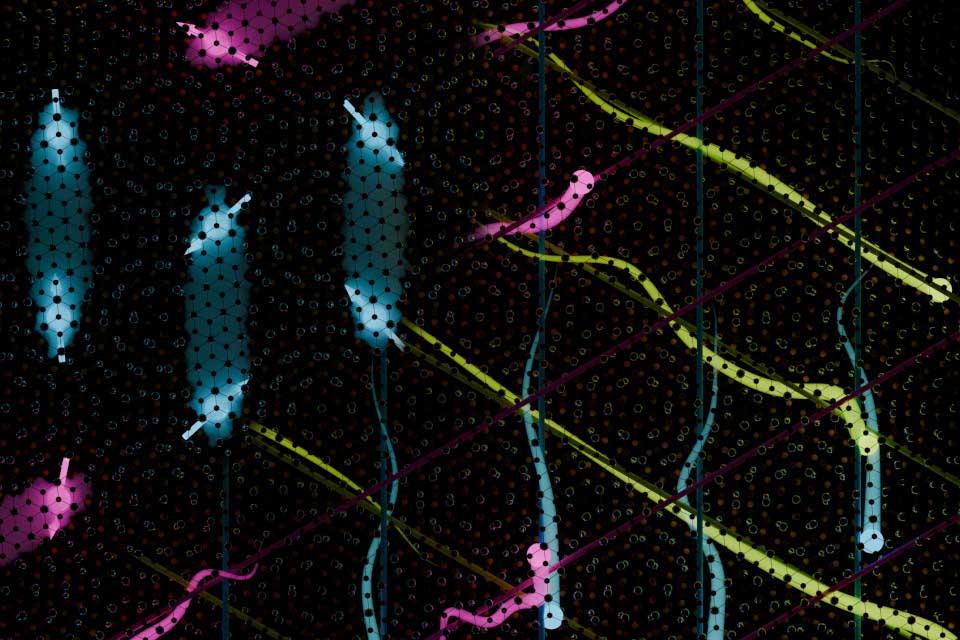An international team has introduced a novel class of twistable quantum materials, opening up a broader landscape for quantum simulation and discovery. Based on a previously unexplored momentum-space point – the M-point – the findings have been published in Nature.
A small rotation between two atomically thin layers can yield dramatic changes in a material’s properties. These so-called moiré materials – formed by twisting two two-dimensional crystal sheets – have quickly become one of the most powerful platforms in modern condensed matter physics. Through careful control of geometry, researchers have learned how to create materials that behave in entirely new ways.
The word moiré may be familiar from photography, where overlapping lines or grids can produce rippling interference patterns. The same concept applies at the atomic scale: by slightly rotating two crystal lattices, new long-range periodicities emerge, reshaping how electrons behave. This seemingly simple twist can have drastic consequences on the properties of the original materials, and even lead to quantum phases once thought to be theoretical curiosities. In graphene, for example, twisting induces superconductivity – a property not present in the monolayer.
Dr Dumitru Călugăru, formerly at Princeton University and now a Leverhulme-Peierls Fellow in the Department of Physics at the University of Oxford, formulated the theoretical framework for M-point moiré materials and is first author of the study: ‘Up to now, all twisting focused on the K-points in the Brillouin zone. But by shifting our attention to the M-points, we are opening up a whole new family of materials and quantum behaviours that were previously inaccessible. The key lies in where the electrons “live” in momentum space.’
Most research on moiré materials has revolved around hexagonal lattices like graphene or transition metal dichalcogenides (TMDs), where twisting near the K-points – special high-symmetry regions – has revealed phenomena such as superconductivity, correlated insulating states, and fractional Chern insulators. Virtually all of the monolayers twisted so far are K-point materials and include graphene, MoTe₂, MoSe₂, and WSe₂.
In contrast, the new study identifies and classifies a broad range of materials whose electronic band minima are located at the M-points – locations in momentum space with entirely different symmetries and quantum properties. From this pool, the team selected two compounds, SnSe₂ and ZrS₂, for detailed investigation.
This effort involved a global team of theoretical and computational physicists, materials scientists, and chemists across Princeton University, Donostia International Physics Center (DIPC), the University of Oxford, the Max Planck Society, Cornell University, LMU Munich, the University of Sherbrooke, and the University of Florida.
‘We found that M-point twisted bands, unlike their K-point counterparts, are topologically trivial – but they're also extremely flat,’ explains Dr Haoyu Hu, a postdoctoral researcher at Princeton. ‘These bands also display an unusual, previously unnoticed symmetry that sometimes gives them a quasi-one-dimensional character, which dramatically affects how electrons interact.’
Through large-scale ab initio calculations carried out over six months, Yi Jiang and Hanqi Pi (DIPC) demonstrated that low-angle twists – around three degrees – flatten the electronic bands significantly. Flattening the bands slows down the electrons and enhances their mutual repulsion, creating ideal conditions for strongly correlated quantum phases to emerge.
‘This flattening can localise electrons in either a hexagonal lattice or a kagome lattice arrangement,’ Dr Jiang said. Dr Pi added, ‘Such localisation means we can now experimentally realise diverse quantum states, potentially including quantum spin liquids.’
Quantum spin liquids – long-sought states where spins remain entangled without forming conventional magnetic order – could unlock future advances in quantum computing and superconductivity. But detecting them has been notoriously difficult, especially due to challenges in precisely tuning material parameters like doping.
Moiré platforms offer new hope: by using electrostatic gating rather than chemical substitution, scientists can finely control electron density without damaging the crystal. This level of tunability marks a significant change.
The paper also identifies additional exotic phases unique to the M-point twist setup, including unidirectional spin liquids and orthonormal dimer valence bond phases – entirely new additions to the quantum matter landscape.
Importantly, this is not just a theoretical proposal. Several predicted materials have already been synthesised in bulk form by quantum chemists Leslie Schoop (Princeton) and Claudia Felser (Max Planck Institute, Dresden). These crystals are now being exfoliated into single layers by leading 2D materials experimentalists Dmitri Efetov (LMU Munich), Jie Shan, and Kin Fai Mak (Cornell University) – the next step toward building moiré heterostructures.
‘The experimental realisation is essential,’ says Professor B Andrei Bernevig from Princeton University. ‘Every time we twist a new material, we’re uncovering unexpected behaviours. Because these systems are so controllable, we’re only beginning to understand the full extent of what’s possible. It’s a new platform for discovering quantum states of matter no one has imagined yet.’
‘So far, just a handful of moiré platforms have already reproduced many textbook examples of strongly correlated phases of matter – and with a level of tunability that's unmatched,’ concludes Dr Dumitru Călugăru. ‘Expanding the class of materials, and pushing beyond the K-point paradigm, makes me optimistic about what lies ahead. We are only scratching the surface.’
Moiré materials based on M-point twisting, D Călugăru et al, Nature, 9 July 2025

